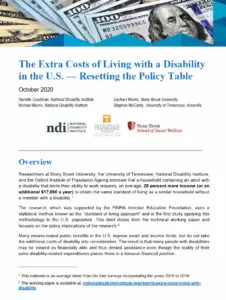
The Extra Costs of Living with a Disability in the U.S
Resetting the Policy Table
National Disability Institute, in partnership with the Stony Brook University School of Social Welfare and the University of Tennessee College of Social Work
- Financial
- Article, Premium Content, Resource Summary
Key Takeaways
- Disability drives major extra costs. A U.S. household that includes an adult whose disability limits work needs about 28 percent more income—roughly $17,700 a year—to maintain the same standard of living as a similar household without disability.
- Current benefits miss the mark. Means‑tested programs and poverty thresholds rarely factor in these costs, so many disabled people remain financially strained yet ineligible for assistance.
- Costs are both direct and indirect. Out‑of‑pocket medical care, personal assistance, accessible housing, and transportation layer on top of lost earnings for the individual and family caregivers.
- Policy fixes exist. Adjusting benefit formulas, expanding tax deductions, and raising ABLE account caps could offset disability‑related expenses and boost economic security.
- Action begins with awareness. Recognizing hidden costs helps people with FND plan, budget, and advocate for the support they deserve.
Click to read full summary
The Essentials
This brief synthesizes national survey data to put a number on what millions intuitively know: living with a disability is expensive. Using a standard‑of‑living regression approach across four large U.S. datasets (2015‑2018), the authors show that disability‑related expenditures push real household purchasing power far below what income alone suggests. That gap widens poverty rates, raises financial vulnerability, and exposes blind spots in safety‑net policies.
The analysis distinguishes direct expenses—medical bills, personal assistance, adaptive equipment, accessible housing—from indirect costs like foregone wages or reduced work hours for family members. It then reviews how U.S. programs (SSI, SNAP, Medicaid, the tax code, ABLE accounts) partially acknowledge those costs, while still leaving most needs unmet. Finally, the authors outline policy options—from resetting benefit eligibility to modernizing savings vehicles—that could relieve the financial burden and promote economic self‑sufficiency.
Why This Matters For FND
Although Functional Neurological Disorder is often considered an “invisible” condition, its impact on finances is very real. Many people with FND juggle specialty appointments, therapy co‑pays, mobility or sensory aids, adaptive tech for fatigue or tremor, and unpredictable work capacity. These expenses fit squarely into the extra‑cost framework highlighted in the brief. Understanding the 28 percent rule of thumb equips our community to budget realistically, document costs for benefit applications, and advocate for fair policy change.
Resource Qualities
Applicability:
Accessibility:
Evidence-Based:
Practical Value:
Practical Application
For Individuals With FND
Low-Energy Days:
- Keep a simple “extra‑cost journal” for one week—note every out‑of‑pocket expense tied to symptoms (e.g., rideshares on flare days, OTC pain gear). This snapshot helps identify the biggest cost drivers without overwhelming effort.
Building Long-Term Wellness
- Explore opening an ABLE account (if eligible) or a high‑yield savings bucket dedicated to disability‑related expenses. Set up an automatic transfer—even $5 per week builds a buffer for sudden costs.
For Care Partners
Supporting Your Loved One
- Offer to help gather receipts and medical documentation when they apply for assistance programs or appeal insurance denials—paperwork stamina is often low during flares.
For Your Wellbeing
- Schedule a quarterly check‑in with a financial counselor who understands disability benefits. Proactive planning reduces stress and protects the household budget.
When This Is Most Helpful
- Early after diagnosis—to set realistic financial expectations and avoid surprise expenses.
- During benefit applications or appeals—data from the brief strengthens the case for accommodations.
- When planning major life transitions (return‑to‑work, moving, family budgeting).
This summary is provided for educational purposes only and does not constitute medical, financial, or legal advice. Always consult qualified professionals regarding your specific circumstances.
